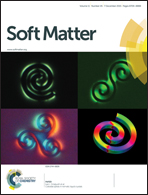Coupling of gelation and glass transition in a biphasic colloidal mixture—from gel-to-defective gel-to-glass†
Abstract
The state transition from gel to glass is studied in a biphasic mixture of polystyrene core/poly(N-isopropylacrylamide) shell (CS) microgels and sulfonated polystyrene (PSS) particles. At 35 °C, the interaction between CS microgels is due to short-range van der Waals attraction, while that between PSS particles is from long-range electrostatic repulsion. During the variation of the relative ratio of the two species at a fixed apparent total volume fraction, the mixture exhibits a gel-to-defective gel-to-glass transition. When small amounts of PSS are introduced into the CS gel network, some of them are kinetically trapped, causing a change in its fractal structure, and act as defects to weaken the macroscopic gel strength. An increase of the PSS content in the mixture promotes the switch from the gel to the defective gel, e.g., the typical two-step yielding gel merges into one-step yielding. This phenomenon is an indication that inter-cluster bond breakage coincides with intra-cluster bond fracture. As the relative volume fraction of PSS exceeds a critical threshold, the gel network can no longer be formed; hence, the mixture exhibits characteristics of glass. A state diagram of the biphasic mixture is constructed, and the landscapes of the different transitions will be described in future studies.


 Please wait while we load your content...
Please wait while we load your content...